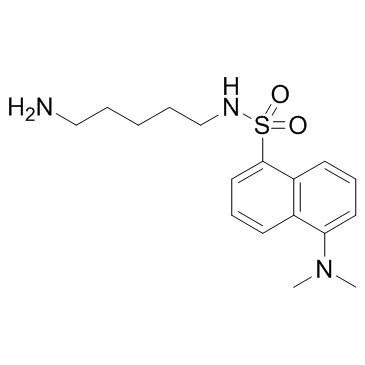Dansylcadaverine

Dansylcadaverine structure
|
Common Name | Dansylcadaverine | ||
|---|---|---|---|---|
| CAS Number | 10121-91-2 | Molecular Weight | 335.46400 | |
| Density | 1.19g/cm3 | Boiling Point | 505.5ºC at 760mmHg | |
| Molecular Formula | C17H25N3O2S | Melting Point | 137-140ºC | |
| MSDS | Chinese USA | Flash Point | 259.5ºC | |
| Symbol |

GHS07 |
Signal Word | Warning | |
Use of DansylcadaverineDansylcadaverine is a fluorescent probe. |
| Name | monodansylcadaverine |
|---|---|
| Synonym | More Synonyms |
| Description | Dansylcadaverine is a fluorescent probe. |
|---|---|
| Related Catalog | |
| In Vitro | Detection of Dansylcadaverine fluorescence after SDS-PAGE shows that the amount of actin-thymosin β4 crosslink is very low in the presence of Dansylcadaverine and transglutaminase, while there are large amounts of Dansylcadaverine-labeled thymosin β4 and actin. The amount of cross-link further decreases in the presence of Dansylcadaverine competing for Lys residues of either G-actin or thymosin β4 (100 μM). In the absence of thymosin β4, Dansylcadaverine-labeled actin polymerized to F-actin as revealed by fluorescence detection after native PAGE[1]. |
| Kinase Assay | To determine the time course of transglutamination, thymosin β4 (120 μM) is incubated with Dansylcadaverine (5 mM) in 70 μL buffer consisting of 10 mM Tris-HCl, pH 7.4, 15 mM CaCl2, 3 mM DTT. The reaction is started by addition of 0.1 U transglutaminase. Immediately after addition of the enzyme (t=0) and at indicated times,10 μL are taken from the mixture, diluted in 490 μL 0.1% TFA to stop the reaction and analyzed by HPLC[1]. |
| Cell Assay | MCF7 cells (2.4×104) are seeded into 35 mm plates. After 24 h incubation, CuO NPs are added with an increasing concentration in the presence or absence of 3-Methyladenine (3-MA) for different time periods . The cells are then incubated with 50 mM Dansylcadaverine (MDC) at 37°C for 15 min and washed with 1×PBS three times with 5 min interval. Finally, the cells are observed under a fluorescence microscope[2]. |
| References |
| Density | 1.19g/cm3 |
|---|---|
| Boiling Point | 505.5ºC at 760mmHg |
| Melting Point | 137-140ºC |
| Molecular Formula | C17H25N3O2S |
| Molecular Weight | 335.46400 |
| Flash Point | 259.5ºC |
| Exact Mass | 335.16700 |
| PSA | 83.81000 |
| LogP | 4.48510 |
| Vapour Pressure | 9.54E-11mmHg at 25°C |
| Index of Refraction | 1.594 |
| Symbol |

GHS07 |
|---|---|
| Signal Word | Warning |
| Hazard Statements | H315-H319-H335 |
| Precautionary Statements | P261-P305 + P351 + P338 |
| Personal Protective Equipment | dust mask type N95 (US);Eyeshields;Gloves |
| Hazard Codes | Xi: Irritant; |
| Risk Phrases | R36/37/38 |
| Safety Phrases | 26-36 |
| RIDADR | NONH for all modes of transport |
| HS Code | 2935009090 |
| HS Code | 2935009090 |
|---|---|
| Summary | 2935009090 other sulphonamides VAT:17.0% Tax rebate rate:9.0% Supervision conditions:none MFN tariff:6.5% General tariff:35.0% |
|
SUMO1 promotes Aβ production via the modulation of autophagy.
Autophagy 11(1) , 100-12, (2015) Autophagy is one of the main mechanisms in the pathophysiology of neurodegenerative disease. The accumulation of autophagic vacuoles (AVs) in affected neurons is responsible for amyloid-β (Aβ) product... |
|
|
Cadherin-6B undergoes macropinocytosis and clathrin-mediated endocytosis during cranial neural crest cell EMT.
J. Cell Sci. 128 , 1773-86, (2015) The epithelial-to-mesenchymal transition (EMT) is important for the formation of migratory neural crest cells during development and is co-opted in human diseases such as cancer metastasis. Chick prem... |
|
|
Reactive oxygen species and autophagy associated apoptosis and limitation of clonogenic survival induced by zoledronic acid in salivary adenoid cystic carcinoma cell line SACC-83.
PLoS ONE 9(6) , e101207, (2014) Salivary adenoid cystic carcinoma is an epithelial tumor in the head and neck region. Despite its slow growth, patients with salivary adenoid cystic carcinoma exhibit poor long term survival because o... |
| Dansylcadaverine |
| N-(5-aminopentyl)-5-(dimethylamino)naphthalene-1-sulfonamide |